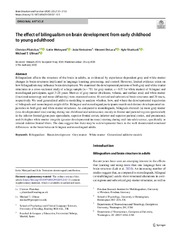| dc.description.abstract | Bilingualism afects the structure of the brain in adults, as evidenced by experience-dependent grey and white matter
changes in brain structures implicated in language learning, processing, and control. However, limited evidence exists on
how bilingualism may infuence brain development. We examined the developmental patterns of both grey and white matter
structures in a cross-sectional study of a large sample (n=711 for grey matter, n=637 for white matter) of bilingual and
monolingual participants, aged 3–21 years. Metrics of grey matter (thickness, volume, and surface area) and white matter
(fractional anisotropy and mean difusivity) were examined across 41 cortical and subcortical brain structures and 20 tracts,
respectively. We used generalized additive modelling to analyze whether, how, and where the developmental trajectories
of bilinguals and monolinguals might difer. Bilingual and monolingual participants manifested distinct developmental trajectories in both grey and white matter structures. As compared to monolinguals, bilinguals showed: (a) more grey matter
(less developmental loss) starting during late childhood and adolescence, mainly in frontal and parietal regions (particularly
in the inferior frontal gyrus pars opercularis, superior frontal cortex, inferior and superior parietal cortex, and precuneus);
and (b) higher white matter integrity (greater developmental increase) starting during mid-late adolescence, specifcally in
striatal–inferior frontal fbers. The data suggest that there may be a developmental basis to the well-documented structural
diferences in the brain between bilingual and monolingual adults. | en_US |


 English
English norsk
norsk